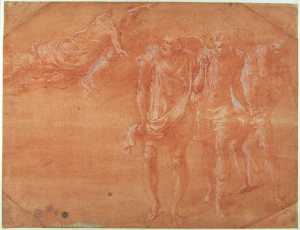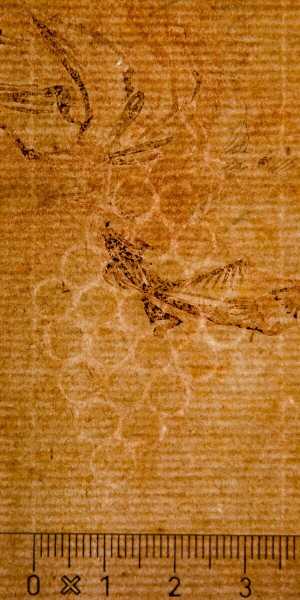Specifications
| Title | Ulysses and Telemachus on Their Way to Laertes |
|---|---|
| Material and technique | Red chalk, heightened with white, on red prepared paper |
| Object type |
Drawing
> Two-dimensional object
> Art object
|
| Location | This object is in storage |
| Dimensions |
Height 221 mm Width 288 mm |
|---|---|
| Artists |
Draughtsman:
Francesco Primaticcio
|
| Accession number | I 297 (PK) |
| Credits | Loan Stichting Museum Boijmans Van Beuningen (former Koenigs collection), 1940 |
| Department | Drawings & Prints |
| Acquisition date | 1940 |
| Creation date | in circa 1555-1559 |
| Watermark | Bunch of grapes, in 8 rows, with stem (55 x 30 mm, below center of folio leaf, to right, between P3-4 of 7P, vV), similar to (but larger than) Briquet 13074 (48 x 33 mm, Lyon 1587, Toulouse 1589-90) and (smaller than) Briquet 13065 (57 x 42 mm, Lyon 1485-1530, Ambérieu 1520, Autun 1520), no good comparable examples in Piccard Online. The same type of watermark, but with initials D and R in an 11-row cluster (57 x 34 mm; ref. Briquet 13154, Lyon 1533), appears in another Primaticcio preliminary drawing for the Odysseus cycle and in a studio copy drawing, now both in Teylers Museum, Haarlem, inv. A* 42 and 40 (Van Tuyll 2000. no. 374, 375). |
| Inscriptions | 'Domenichino' (verso, top centre, pen and brown ink), 'Mazzuola' (verso, centre, pencil), various numbers (verso) |
| Collector | Collector / Franz Koenigs |
| Mark | E. Wauters (L.911), F.W. Koenigs (L.1023a) |
| Provenance | Jean-Baptiste-François Nourri (1697-1784), Paris; his sale, Paris (Folliot) 24.02.1785, probably lot 463 (FF 20 to Martini); - ; Emile Wauters (1846-1933, L.911), Paris; his sale, Amsterdam (Muller) 15-16.06.1926, lot 142 (' Le départ de Loth. L'ange planat presse Loth et ses deux beaux-fils de quitter Sodome', for Fl 525 to Durlacher for d'Hendecourt ); Viscount Bernard d’Hendecourt; his sale, London (Sotheby’s) 08-10.05.1929, lot 246 (BP 62 to Beets); Franz W. Koenigs (1881-1941, L.1023a), Haarlem, acquired in 1929; D.G. van Beuningen (1877-1955), Rotterdam, acquired with the Koenigs Collection in 1940 and donated to Stichting Museum Boijmans Van Beuningen |
| Exhibitions | Amsterdam 1934, no. 626; Paris 1972, no. 172; Rotterdam 1997-98; Rotterdam 2009 (coll 2 kw 1) |
| Internal exhibitions |
Rondom Raphaël (1997) De Collectie Twee - wissel I, Prenten & Tekeningen (2009) |
| Research |
Show research Italian Drawings 1400-1600 |
| Literature | Lees 1913, pp. 89-90, fig. 101; Amsterdam 1934, no. 626; McAllister Johnson 1966, pp. 25, 28 n. 3, pl. 16; Rondorf 1967, pp. 106-107; Mullaly 1969, pp. 631, n. 2; Paris 1972, no. 172, ill.; Béguin et al. 1972, pp. 6-7, fig. 7; Bjurström 1976, under no. 29; Bequin/Guillaume/Roy 1985, pp. 312-13; New York 1987, p. 27 |
| Material | |
| Object | |
| Technique |
Prepare
> Prepared
> Shaping techniques
> General technique
> Technique
> Material and technique
Prepare
> Prepared
> Shaping techniques
> General technique
> Technique
> Material and technique
Highlight
> Painting technique
> Technique
> Material and technique
|
| Geographical origin | Italy > Southern Europe > Europe |
| Place of manufacture | Bologna > Italy > Southern Europe > Europe |


























